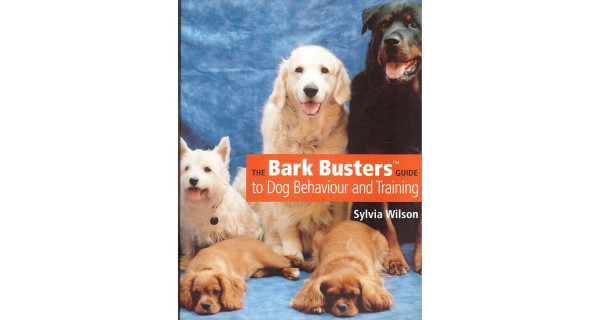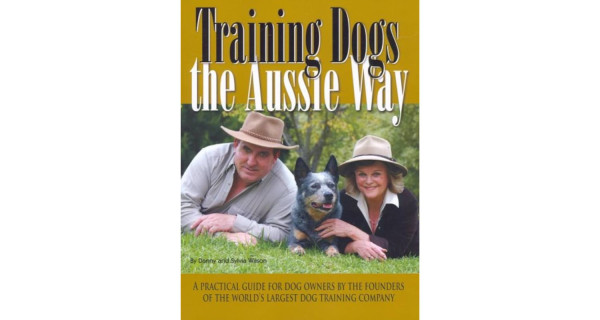Bark Busters Books
If you are thinking of buying a puppy or dog, or you have one already, the books found on the side will help you. From a step by step guide selecting the right puppy for you, to curing your dog bad habits. You’ll be able to find everything you need from finding the right dog, to training them to be a well-behaved member of the family.

We fell for the television advertisements. You know, the one with the Labrador puppy, selling toilet paper. We bought the Labrador pup – cute, bouncy and just a little bit naughty. We called her Lucy.
Six months later, she’d grown to 20 kilos of bounce. She wasn’t cute. Lucy was a juvenile delinquent. She dug enormous holes in the garden. She ate two TV remote controls. She raided the garbage and bailed up our friends. Then came the phone. ‘Telecom.’
‘You may find this hard to believe, but our dog ate the phone …’
‘Labrador?’ ‘Yes, but …’ ‘We’ll send a technician.’
We called in Bark Busters. 1 expected a platoon dressed in full metal jackets, armed with rubber bullets. Sylvia wore high heels and a houndstooth suit. She spoke briefly to Lucy who realized she was outclassed and lay obediently at Sylvia’s feet. Sylvia told us the facts of life. We were people. Lucy was a dog. Dogs need manners. Training a dog isn’t cruel. The dog doesn’t speak English. All those things and more, you’ll learn in this book.
Sylvia showed us the simple, practical steps to good doggie manners. She demonstrated the magic word ‘Bah’, and a few other tricks.
These days, we are the people and Lucy is the dog. A calm, sensible, well-mannered dog. A dog that is a pleasure to have. That’s what this book will give you too.
Helen Townsend

As a veterinary surgeon, I am often approached to give my approval of some new product or technique. More often than not I politely decline, aghast at the principle or theory behind the idea. It was therefore with a sense of trepidation that I agreed to read and then comment on Sylvia’s book on how to deal with dog attacks.
Happily, it is a book where commonsense prevails. It debunks the myths and exposes the old wives’ tales that cause me so much hassle and grief in my daily duties at work. I have long realized, as a woman vet, that brute force and confrontation are rarely; if ever, the correct way to interact with any animal – large or small. Greater success is usually achieved by understanding how my patient is interpreting the situation and playing by pack rules, along with a liberal dose of blarney and bribery by way of treats.
Many euthanasia on dogs are due in no small part to the human at the other end of the lead completely misreading the situation and expecting their beloved pet to be beyond reproach. I often hear owners who say their dog is wonderful with kids and would never bite. But all dogs, given the right set of circumstances, will bite and we have a duty to be aware of those situations and avoid the unnecessary stress to the pet and grief to ourselves.
Sylvia’s book goes a long way to informing us of those situations, how to avoid them where possible and what to do should we find ourselves in an attack situation.
Bite Busters makes excellent and easy reading and is a must for vet students and nurses, meter readers, dog owners and anyone who comes into regular contact with dogs. Empowered with an alternative view to some of the current theories on dog control, readers will enjoy a safer and more rewarding daily interaction with their four-legged friend.
Just remember, as Sylvia says, humans smack with their hands, dogs smack with their mouths, and while we may fail to be consistent in our application of the laws of the pack, our beloved pet will not.
Aine Seavers MRCVS, MVB
Introduction
It is my belief that dogs prefer to be trained. Training makes their lives better balanced and more purposeful and they are accepted by society, which appreciates an obedient hound. An unruly dog is only a reflection of its owner’s inability to communicate with it.
As a young boy living in the cold north-east English countryside, my family owned two purebred Whippets, who we named Bones and Spock after the “Star Trek” characters.
Managing dogs as a profession began to interest me when I noticed that a friend’s German Shepherd would bite him, yet never bite me. I began to realize that this dog had greater respect for me than for its owner, even though I spent less time with it.
I also began to wonder why some dogs act erratically toward their owners, while others show great respect for and good manners toward the dog’s best friend, the human. I began observing dog behavior very closely and worked with the dog experts in our village.
From this small beginning, I went on to work with thousands and thousands of dogs in both hemispheres, progressing from the wide-eyed student with an interest, to a specialist in determining and solving the behavioral problems of dogs.
My home therapy is usually divided equally between dog and owner. Most problems stem from a lack of understanding on the owner’s part. Once the owner understands why the dog becomes neurotic, I can help solve most of its behavioral problems.
Danny Wilson

From choosing your puppy from the litter to training it to live well in your home this is a practical puppy manual for your first critical months in your puppy's life. Includes room on each page for your own note-taking.
"I got Gus at 3 months old, and I could tell from the second I saw him something was just not right. I could tell by the way he acted towards me he had not been socialized. For the first two days, he would just go round in circles, after about the third day he stopped growling at me and my husband. As he started to to get older he was very scared of new things and people, to the point I was afraid to take him anywhere. I had talked with my local Bark Busters trainer and asked her to stop by and take a look at him, to see if she could help. As soon as I brought him out to see her he stood behind me. Cheryl worked with him for about an hour, even though he was growling and snapping. She worked with him gently and patiently to get him to understand that people were not bad and by the end of that hour he was sitting in her lap relaxed. She never used anything physical or harsh. It was her body language and voice tones that got him relaxed. I enrolled him in the Bark Busters puppy class. I was afraid to take him anywhere before his training, and being a Rottweiler I had to be careful.
If you would meet him now you would never know he ever had problems. He goes to nursing homes, parades, and pretty much anywhere I go. I have his sister from a different litter and she was worse than he was. I couldn't get her out of her crate without her charging with her front teeth bared. She also has completed the Bark Busters puppy training and is a totally different dog. She went from being a scared, aggressive puppy to a happy goofy girl. I cannot thank by Bark Busters trainer enough for changing the outcome of the lives of my dogs. They would not be able to enjoy the events we do, without Bark Busters help. I truly feel I would have had two very aggressive Rottweilers had Bark Busters not worked with me and with the issues my puppies had."
Puppy Owner, Melissa Jarrett
Toledo Ohio USA

When I met Sylvia, I had been living an unbearable life with very little meaning. My world had shrunk to a very uninteresting place, and I was always running around in circles, chasing my tail, never knowing which way to turn.
I vividly remember meeting Sylvia. The day was hot and sultry and I was all strung out and stressed again. This feeling of being out of control had started to overwhelm me. I had lost the ability to communicate with the people around me and no longer had any friends. They had all grown up and moved on to enjoy their lives, while I couldn’t get my life together. You have probably realized by now that I’m a dog – in fact, a handsome male German Shepherd called Tonka.
My friends down at the park had told me all about Sylvia. It was love at first sight. I considered myself to be rather good-looking, although young and inexperienced. Sylvia obviously saw some potential in me that no else could see. She believed that I could live a normal, happy life, and through patience and understanding she made me whole again. Sylvia’s gentle touch made me feel alive and gave me a purpose. I am no longer spinning out of control. Sylvia Wilson, you’re a wizard.
Tonka (German shepherd, aged 9 months)
Introduction
If you are thinking of buying a puppy or you already have one, this is the book for you. This book will guide you through, step by step, how to select the right puppy to suit your needs, and how to rear and train your puppy so it will grow into a well-behaved member of the family. Covers effective non-physical discipline methods, toilet training, basic commands, and solving common problems such as barking and jumping up.

Ask not what to do for your dog-but what you want your dog to do for you!
Okay, so it’s not an entirely original thought. But, after nearly 20 years with the media as a reporter/producer, I thought I’d seen, heard and reported on just about every “new” approach to everyday problems. Then I met Danny and Sylvia Wilson. In one short lesson I watched them cure two barking, out-of-control, food-aggressive spaniels.
Although I watched and videotaped the entire session (which was later broadcast on Australia’s Seven Network program 11 AM), for the life of me I couldn’t work out exactly how they did it.
Somehow, Danny and Sylvia seemed to know a split second before the dog itself that an attack, involving lightning-fast, bonecrunching bites, was about to occur. Those teeth never connected with flesh, the barking was halted, the dogs walked calmly on leads, and within an hour the eternally grateful owner was well on the way to being able to exert similar control.
How do they do it? Well, to put it simply, Danny and Sylvia Wilson have unraveled the secrets of doggy body language. They’re the Allan Pease of the dog world! (I’m referring to the human body language expert and author of several books on how to control others by understanding their gestures well enough to read their thoughts.)
Now, at long last, the Wilsons have explained the techniques I couldn’t fathom in this book. I couldn’t put down Train Your Dog the Easy Way, because at long last it became clear to me what makes dogs tick, and how we humans can easily take advantage of our knowledge of doggy protocol in order to be in command.
Also, as you will discover, it’s fun to read about the classic mistakes we make when training dogs–and to realize how easily they can be corrected with Danny and Sylvia’s simple methods. I wish they’d written this book years ago!
Which brings me back to my opening line about what we want from our canine pals. We want a dog that’s happy and well adjusted because it knows exactly what is and isn’t acceptable to us, and exactly where it fits into the “pack” that inhabits its particular home.
I can’t help but think that the more we know about communicating with dogs, the less chance there is of us, and especially our children, being accidentally bitten by them.
So, with Danny and Sylvia’s book in hand, I’m off to practice my new-found knowledge on my new puppy, Kismet, in the hope that she’ll be less confused than her older playmate Cosmo who, at 18 months of age, will be learning that older dogs really can be taught new tricks!
Kaye Browne Freelance TV Producer/Writer
Meeting Danny and Sylvia Wilson was a real eye-opener for me, not to mention what it did for our German shepherd, Beowulf. Beo is three and a half years old, and has been the boss of our house all his life.
I was introduced to the Wilsons and their philosophy through my daughter Tracey, a journalist who’d met them while doing a story. She called me that same day to say, “Dad, you’ve just got to see what these guys can do. You won’t believe it. And it’s so simple!”
I was, to put it mildly, highly skeptical. After all, I’d owned and trained four German shepherds over the years, so I was something of an expert, right?
Beo has never really been a problem. He just pulls me all over the place when we’re out walking, and takes off after dogs, cats, birds, and, for reasons known only to himself, white Toyota vans. If I don’t let go of the lead I get dragged along the grass.
Well, guess what? In just 15 minutes Danny and Sylvia changed it all. Beo is a new dog. He now walks with me, with or without the lead, and he never leaves my left side. He is continually looking at me, waiting for his next command. He was always a beautiful dog; he’s just better now.
Danny and Sylvia said that I must get my clog’s respect. Well, I have that now. But, more importantly, the Wilsons have mine. Thank you Danny, and Sylvia.
Philip Curro Dog Owner

Sylvia Wilson and her husband, Danny, are the co-founders of the worlds largest dog training company, Bark Busters. They have spent the last 18 years training dog trainers, dog owners, and dogs in hundreds of cities across eight countries. Their secrets are now revealed in a new book, Training Dogs The Aussie Way.
Sylvia discusses and explains:
- How to raise a well-behaved, fun-loving dog.
- Why the toughest-to-train dogs don't need to be euthanized – just understood
- How to choose a dog breed based on your personality.
- Two things that primarily influence a dogs behavior: instinct and experience.
- Why your dog acts the way it does.
- When to growl “Bah” at your dog and why saying “No” is useless.
- How to ease a puppy's transition into its new home.
- Why teaching your dog to come or react immediately to your command is important.
“Dogs not only feel instinctively more at ease, but are also safer and better accepted by society when they are part of an ordered pack with a strong leader that provides guidance through discipline and praise,” explains Sylvia. “As your dogs owner and pack leader, it is your responsibility to provide the kind of training the dog would otherwise receive from its mother, family members, and even siblings, depending on its positioning in the pack.”
Sylvia co-founded Bark Busters in order to establish a global network of dog behavioral therapists and trainers who can enhance enjoyable and responsible dog ownership – and to reduce the very sad possibility of mistreatment, abandonment, and euthanasia of companion dogs. She, along with Danny, ended up building the largest, most trusted home dog training company in the world.
Based in Australia, some 50 miles from Sydney, Bark Busters has grown since its inception in 1989, and expanded to 340 franchised offices across New Zealand, The United States, Canada, The United Kingdom, Israel, Taiwan, and Japan. Over 350,000 dogs – and their owners – have experienced the proprietary holistic and humane dog training system. With 235 locations in the U.S., they serve 40 states and over 100 American cities. Entrepreneur magazine rated Bark Busters as the #1 Pet Service Franchise in America.
Horrified by the substantial number of dogs being euthanized due to behavioral issues, Sylvia made a pledge to get the word out that almost any dog can be successfully trained.
Sylvia has helped new dog owners, owners of puppies, frustrated dog owners, parents concerned about their dog and family interactions, dog shelter personnel, animal control officers, and veterinarians. She travels the world advocating for natural, humane training methods and championing responsible dog ownership to enhance the human-canine bond, addresses these challenging behaviors and many more:
- Dogs who display unwarranted aggression toward humans or dogs.
- Canine kleptomaniacs, show-chewers, and dogs that mark in the house.
- Barking at night, at neighbors, at guests, out a window, or when a car goes by.
- Dogs who eat garbage or beg for food, or act unfriendly towards groomers and vets.
- Yard-diggers, run-aways, hand-nippers, and separation anxiety sufferers.
“The good news is that most dogs can be successfully trained, even those that have been abused or allowed to develop bad habits as a result of inadequate or not training,” says Sylvia. “Discipline and leadership are not enemies of fun. Training doesn't inhibit a dogs playfulness or spontaneity.” Most dog owners simply accept the disruptive or aggressive behavior of their dogs because they think it is normal or don't know how to change it. Learning about pack leadership and canine communication is incredibly interesting for dog lovers. By gaining a better understanding of the dog psyche you can strengthen the human-dog connection. “Understanding your dogs nature and how it learns is necessary to train it effectively and to ensure its safety and well-being,” says Sylvia. “By learning how to select the best dog for your personality and lifestyle – and how to raise it to be a healthy and happy animal – is the best gift you can give your dog and yourself.”
Publication Data: Training Dogs the Aussie Way by Sylvia and Danny Wilson; StarJunction Books; Trade Paper; 6 x 9; $19.95; 208 pages; ISBN: 978-0-9790956-1-0

